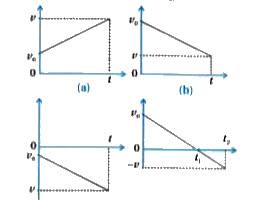Draw and explain the v→t graphs for uniformly accelerated motion.Solution in Gujrati
Velocity-time graph for motion with constant acceleration are as following:

An object is moving in a positive direction with a positive acceleration, then graph (a) is obtained
An object is moving in positive direction with a negative acceleration, then graph (b) is obtained.
An object is moving in negative direction with a negative acceleration, then graph (c) is obtained.
An object is moving in positive direction till time t1 and then turning back and moving with the same negative acceleration. This is shown in graph (d).
An interesting feature of a velocity-time graph for any moving object is that the area under the curve represents the displacement over a given time interval.
Topper's Solved these Questions
- MOTION IN A STRAIGHT LINE BOOK - KUMAR PRAKASHANCHAPTER - MOTION IN A STRAIGHT LINE EXERCISE - SECTION-A TRY YOUR SELF (VSQs)
52 Videos
- MOTION IN A STRAIGHT LINE BOOK - KUMAR PRAKASHANCHAPTER - MOTION IN A STRAIGHT LINE EXERCISE - SECTION-B
58 Videos
- MECHANICAL PROPERTIES OF FLUIDS BOOK - KUMAR PRAKASHANCHAPTER - MECHANICAL PROPERTIES OF FLUIDS EXERCISE - QUESTION PAPER (SECTION -C)
3 Videos
- OBJECTIVE QUESTIONS AS PER NEW PAPER STYLE BOOK - KUMAR PRAKASHANCHAPTER - OBJECTIVE QUESTIONS AS PER NEW PAPER STYLE EXERCISE - CHAPTER - 8 (Match Type questions)
5 Videos
Similar Questions
How can we determine whether the object is in rest or not?
View SolutionA car is moving along a straight line, say OP in It move from O to P in 18 s and returns from P to Q in 6s, where OP=360 m and OQ=240 m. What are the average velocity and average speed of the car in going (a) from O to P ? And (b) from O to P and back to Q ?
View SolutionGlycerine flows steadily through a horizontal tube of length 1.5m and radius 1.0 cm . If the amount of glycerine collected per second at one is 4.0×10−3kgs−1 , what is the pressure difference between the two ends of the tube ? (Density of glycerine =1.3×10103kgm−3 and viscosity of glycerine =0.83 Pa s). [ you may also like to check if the assumption of laminar flow in the tube is correct]
View SolutionType of satellites are given in Column-I and their uses are given in Column-II. Match them properly :
Column-IColumn-II(1) Polar satellite(a) Tele communication(2) Geo-stationary satellite(b) Investigation(c) For information about atmosphere
View SolutionDraw velocity – time graph of uniformly accelerated motion in one dimension. From the velocity – time graph of uniform accelerated motion, deduce the equations of motion in distance and time.
View Solutionसंलग्न चित्र में गतिमान वस्तु के लिए v−t ग्राफ प्रदर्शित किया गया है । वस्तु का त्वरण क्या होगा? वस्तु की गति के लिए x−t ग्राफ खींचिए ।

View SolutionKinematics Mixed Concepts(Relative motion,uniformly and non uniformly accelerated motion,graphs,equation of motion)
View SolutionKinematics Mixed Concepts(Relative motion,uniformly and non uniformly accelerated motion,graphs,equation of motion)
View SolutionRepresent the velocity-time graph for a uniformly accelerated motion when acceleration is positive.
View SolutionSlope of v rarr t graph of body having accelerated motion is …... .
View SolutionDraw v to t graph for constant velocity and explain it.
View SolutionExplain by drawing graphs of displacement x(t)→t, velocity v(t)→t and acceleration a(t)→t of SHM for initial phase zero.
View SolutionDraw the position-tie graph for uniformly accelerated motion. What does its slope give ?
View SolutionDraw the velocity-time graph for uniformly accelerated motion. Show that slope of the velocity-time graph gives acceleration of the object.
View SolutionDerive the following equations of motion for uniformly accelerated motion from velocity-time graph : v2−u2=2as
View Solution
